Humidification
Why is Humidification Important?
The nose functions to warm, moisten, and filter the air we breathe. In a child with a tracheostomy, air goes directly into the lungs through the trach tube. Extra humidity may be needed to:
- Keep mucus loose
- Prevent the tracheostomy tube from getting plugged up with hard, dried mucus
- Prevent coughing from dry air
Ways to Provide Extra Humidification
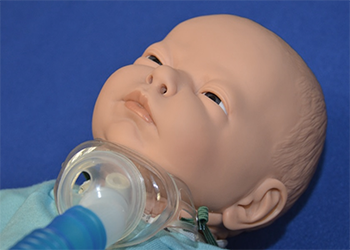 Collar that is placed over tracheostomy tube.
Collar that is placed over tracheostomy tube.- Can deliver oxygen if needed
- Recommended at nighttime and nap time for infants and smaller children
- Recommended for all children if secretions are thick and during times of respiratory illness
Note: An adequate amount of water is needed to supply a sufficient mist
View a video on how to use an HME on a trach tube.
View a video on how to use an HME with a ventilator circuit.
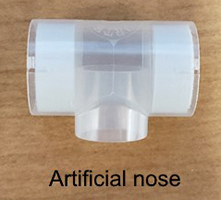 Acts to capture the child’s own warmth and moisture in their airway
Acts to capture the child’s own warmth and moisture in their airway- Filters small particles from entering airway
- Used when off the mist collar when child is awake
- May help protect the airway on cold and windy days when outdoors
- Need to watch closely to make sure it does not become plugged with secretions.
- Change at least daily and when full of secretions. If HME becomes wet with secretions or plugged, throw it away and replace it with a new one. You cannot clean the HME.
- Your child’s HME can only be used for 24 hours and must be thrown out after this time.
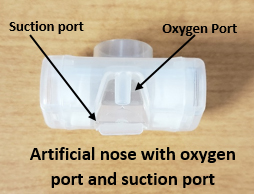 Remove HME if child becomes agitated (may be a sign it is plugged with secretions)
Remove HME if child becomes agitated (may be a sign it is plugged with secretions)- Some HME’s have additional ports on them as seen here. The oxygen port allows you to deliver oxygen if needed and the suction port opens and allows you to suction your child without removing the HME.
- Machine which adds extra moisture to a room
- Sometimes used by older children who do not like mist collars
- Good to use when the air is very dry
- Need to make sure the humidifier is clean at all times. Filters may get moldy. Follow manufacturer’s guidelines for cleaning.
During winter home heating season, the air in your house may be drier. Humidification needs may increase to prevent irritation and tracheal plugging.
Nebulizer Treatments
Your child may require nebulizer treatments at home. If so, you’ll have a nebulizer machine at home.
The nebulizer machine delivers medicine as a mist. Your child breathes it into their airway. Then the lungs absorb it.
Attach the nebulizer to the elbow of the trach collar.
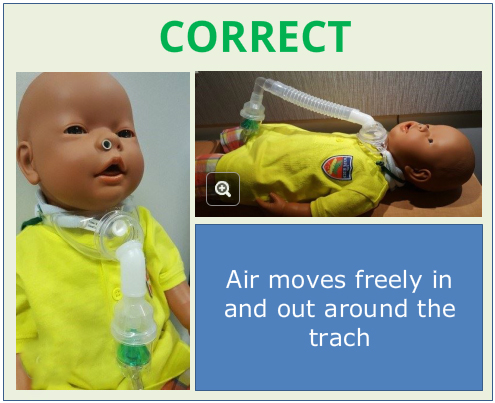
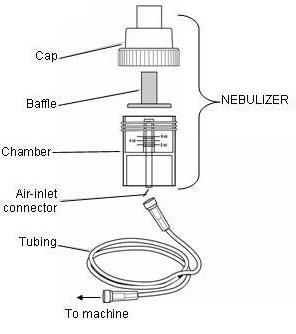
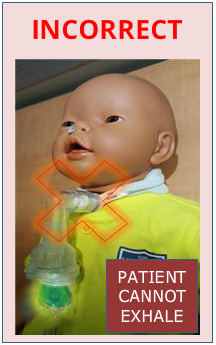 NEVER attach the nebulizer directly to your child's tracheostomy.
NEVER attach the nebulizer directly to your child's tracheostomy.
This will cause air to flow into your child at too high of a rate, and it prevents for your child from breathing out, which can cause many problems.
Giving a Nebulizer
- Nebulizer kit with medication cup
- Medicine
- Nebulizer (aerosol) machine
If your child wiggles around a lot you may need a second adult to help keep your child in a safe position.
If your child wears an artificial nose, remove it before starting. Replace it afterward.
- Wash your hands
- Place baffle into nebulizer chamber.
- Place medicine into the nebulizer chamber.Screw the cap onto the chamber.
- Connect the trach mask or collar to the top of the nebulizer cap.
The nebulizer should always be given with a trach mask/collar to prevent problems. - Connect one end of the tubing to the bottom of the nebulizer. Connect the other end to the aerosol/nebulizer machine.
- Place trach mask or collar over tracheostomy.
- Plug in the aerosol machine.
- Turn the machine on.
- Once nebulizer is done, suction your child’s trach to remove secretions.
Cleaning the Humidification Equipment
- Clean with hot soapy water
- Rinse completely
- Allow to fully air dry
- Clean with hot soapy water
- Rinse completely
- Allow to fully air dry
- Rinse and refill daily to prevent bacterial growth.
- Be sure to check machine air filters regularly. Bacteria, mold, and dust can collect quickly. Follow manufacturer guidelines for cleaning.